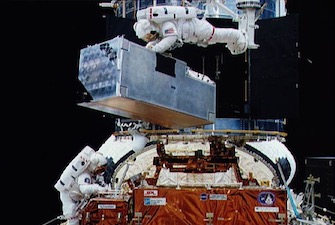
Corrective Optics Space Telescope Axial Replacement (COSTAR) prior to its installation on the Hubble Space Telescope.
For 25 years, the Hubble Space Telescope has returned images to Earth of far-off nebula and celestial bodies, which humans had never before seen. Data collected by Hubble has allowed scientists to detect the presence of black holes in the universe and determine the age of the various galaxies in our universe. Indeed, there are few instruments that have ever been created by man which have proven to be more scientifically productive than the Hubble.
Those who remember the earliest days of the Hubble mission will recall the tension surrounding a mechanical problem afflicting the Hubble. Though the first images returned by Hubble were better than anything captured by telescopes here on Earth, but NASA scientists quickly realized that the images weren’t as sharp as they should have been. Instead of letting the ill-formed telescope languish in space, NASA embarked on a project that would eventually restore the Hubble Space Telescope to its intended clarity of vision.
Spherical Aberration: The Vision Problem Facing Hubble
Spherical aberration is an issue which has faced telescope makers for centuries. A spherical aberration can occur when a lens with a spherical surface is not perfectly shaped. This then causes the light rays traveling through the lens to converge at varying points along the optical axis of a lens. This has the effect of creating a blurry and imperfect representation of an image being viewed by a telescope.
When early telescopes utilized spherical mirrors to address issues of chromatic aberration they began to run into issues of spherical aberration. In 1663, Scottish astronomer James Gregory published a book called Optica Promota which showed that spherical aberration could be eliminated if the curved surface of the spherical mirror had a perfect parabolic shape.
Although scientists understood the problems causing both spherical and chromatic aberration by the 17th century, it wouldn’t be until the 18th century that a working solution to both would be suggested. Swiss physicist Leonhard Euler, considered by some to be the greatest mathematician of all time, published a paper in 1747 arguing that it was possible to correct both chromatic and spherical aberration in an “object-glass” because the human eye was capable of detecting images so sharply. Unfortunately, Euler was unable to construct a prototype proving his hypothesis. Euler’s work was, however, improved upon and a working lens without chromatic or spherical aberration, the achromatic telescope, would be developed within a few decades thanks to the work of British optician John Dollond and Swedish mathematician Samuel Klingenstierna. Issues with chromatic and spherical aberration in microscopes wouldn’t be addressed until the 19th century.
It was this problem of spherical aberration that almost turned Hubble from a major step forward in space exploration to a heavy chunk of metal that was only slightly better than earth-bound telescopes. On June 27th, 1990, NASA held a press conference where it announced to the world that a tiny inaccuracy in the machining of Hubble’s primary mirror would cause the space telescope to fail at some of its mission objectives.
The cause of the aberration occurred while finishing the primary mirror before it was installed on Hubble. The mirror, which measured eight feet in diameter, was polished slightly too flat on its edges because of a malfunction in a measuring device used during the polishing procedure. The error was not detected until Hubble was airborne but the problem was enough to affect the parabolic shape of the mirror. This resulted in the vision problem that kept Hubble’s imagery fuzzy for more than three years. All of this because the primary mirror was a total of four microns too flat at the edges of the mirror.
COSTAR: The Mission to Save Hubble
Luckily, there had been those who had already given some thought to the fact that NASA might want a backup plan in place just in case anything ever did go wrong with Hubble. One of the program scientists involved with the creation of Hubble, Ed Weiler, had made a push back in 1985 to ensure that the program was provided with an extra Wide Field and Planetary Camera (WFPC2). Much like the original WFPC, this component was comprised of a number of charge-coupled devices that could record images in a digital medium instead of film. The detectors were sensitive enough to see objects that were 1,000 fainter than what the human eye could view. As another Hubble project scientist, Dave Leckrone, would remember later, Weiler’s point of view was that “it is unthinkable that Hubble should ever go blind. That was the mantra. We could never allow Hubble to go blind, so let’s build a replica of WFPC.”
WFPC2 was completed and ready for launch by the end of 1993 but it would not be NASA’s only response to the image quality problem posed by Hubble’s faulty mirrors. To ensure that there would be no further problems with the image quality retuned by Hubble’s Optical Telescope Assembly, NASA researchers developed a telescope component known as the Corrective Optics Space Telescope Axial Replacement (COSTAR). This new component involved an assembly of specially designed mirrors intended to correct any issues with spherical aberration. It operated by creating multiple focal points instead of a single focal point for ultimate image clarity. In essence, COSTAR was to act as a pair of eyeglasses for the Hubble Space Telescope.
During the three-year interim needed to complete the production of Hubble’s corrective components and plan the installation mission, NASA understandably dealt with a lot of criticism from the mainstream press. The concept of Hubble trouble almost became a journalistic beat unto itself. On December 2nd, 1993, NASA finally got its chance to address the naysayers when Service Mission 1 for the Hubble Space Telescope rumbled towards the skies carried onboard the Space Shuttle Endeavour.
Once the Endeavour caught up to the orbiting telescope, the crew managed to draw Hubble towards the shuttle’s cargo bay for the necessary repairs. Over the course of five days, astronauts from the Endeavour worked to install both WFPC2 as well as the COSTAR optical correcting component. Other improvements made during this first service mission include new solar arrays which created less jittery movement whenever the telescope was warmed by the Sun’s rays as well as gyroscopes designed to help improve the pointing accuracy of Hubble.
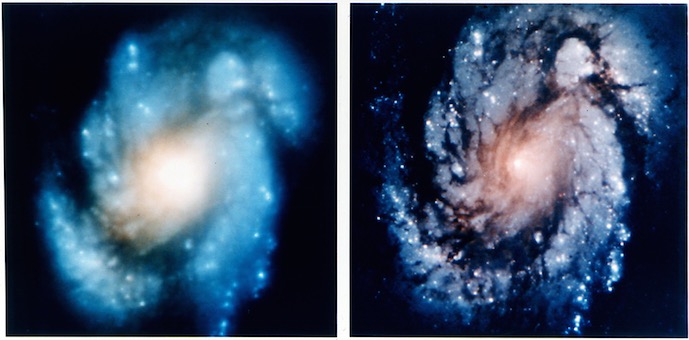
Comparison image of the core of the galaxy M100 shows the dramatic improvement in Hubble Space Telescope’s view of the universe after the first Hubble Servicing Mission in December 1993.
The moment of truth on whether Hubble’s corrective lenses would provide the picture quality improvements envisioned by NASA came on January 13th, 1994. On that day, NASA recorded before and after photos of galaxy M100 (shown above) situated tens of millions of light years away from Earth. The incredible clarity of M100 in the photos recorded after WFPC2 and COSTAR were installed were proof that STS-61 Hubble Servicing Mission was a success.
STS-61 was not the only servicing mission put together to improve the functionality of the Hubble Space Telescope. The second servicing mission to Hubble, STS-82, took place over ten days during February 1997 and resulted in the installation of the Near Infrared Camera and Multi-Object Spectrometer (NICMOS). NICMOS would make Hubble capable of viewing the most distant galaxies which can only be detected through infrared readings. The Space Telescope Imaging Spectrograph (STIS), also installed during this servicing mission, would help Hubble be able to detect the presence of black holes in the universe.
The third servicing mission to Hubble was broken up into two parts, one that took place in December 1999, the other completed during March 2002. STS-103, the first part of this particular servicing mission, focused mainly on the replacement of all six gyroscopes installed on Hubble. Also replaced was one of the telescope’s three Fine Guidance Sensors, which improved the telescope’s accuracy when pointing at celestial bodies far out in space. STS-109, the second part of this servicing mission, involved astronauts installing a component known as the Advanced Camera for Surveys (ACS) over the course of five spacewalks. The ACS essentially doubled Hubble’s field of view in the dark skies of the universe. This particular mission also served to restore NICMOS operations, which had stopped once the spectrometer had run through its supply of nitrogen ice coolant. The mission also installed more efficient solar arrays and a more effective steering system.
The latest, and likely final, servicing mission intended to upgrade the Hubble Space Telescope took place over two weeks in May 2009. This mission, STS-125, was the one that removed both the WFPC2 and COSTAR components, which had saved Hubble in 1993 out of commission. In place of WFPC2, astronauts installed Wide Field Camera 3 (WFC3), which had a greater resolution than WFPC2 and could see near-ultraviolet, near-infrared and visible light wavelengths. COSTAR was replaced by the Cosmic Origins Spectrograph (COS), a spectrograph which sees ultraviolet light exclusively and increased Hubble’s sensitivity to ultraviolet light anywhere from 10 times to 70 times. This mission also involved on-site repairs of both the ACS and the STIS, both of which had failed due to various electronic problems. New gyroscopes and batteries were also installed so as to allow Hubble to function for years after this final servicing mission.
During the course of the entire Hubble Space Telescope mission, NASA experienced some great lows, but also some spectacular triumphs. The service missions to fix and upgrade Hubble proves the unwillingness of NASA scientists and engineers to accept any form of failure in its mission to explore the deepest reaches of outer space. As the space exploration agency readies itself for the October 2018 launch of the James Webb Space Telescope, which is the next iteration of space-based telescope observation, it’s good to look back and see how the agency was able to successfully rectify an issue which could have been one of NASA’s gravest mistakes.

![[IPWatchdog Logo]](https://ipwatchdog.com/wp-content/themes/IPWatchdog%20-%202023/assets/images/temp/logo-small@2x.png)

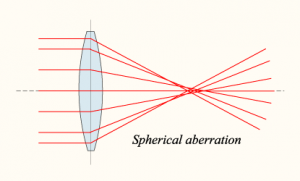
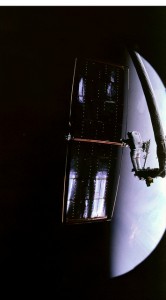
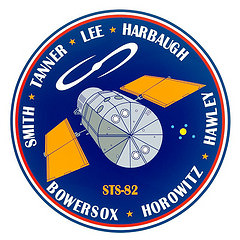
![[Advertisement]](https://ipwatchdog.com/wp-content/uploads/2024/03/IP-Copilot-Apr-16-2024-sidebar-700x500-scaled-1.jpeg)
![[Advertisement]](https://ipwatchdog.com/wp-content/uploads/2024/04/Patent-Litigation-Masters-2024-sidebar-early-bird-ends-Apr-21-last-chance-700x500-1.jpg)

![[Advertisement]](https://ipwatchdog.com/wp-content/uploads/2021/12/WEBINAR-336-x-280-px.png)
![[Advertisement]](https://ipwatchdog.com/wp-content/uploads/2021/12/2021-Patent-Practice-on-Demand-recorded-Feb-2021-336-x-280.jpg)
![[Advertisement]](https://ipwatchdog.com/wp-content/uploads/2021/12/Ad-4-The-Invent-Patent-System™.png)







Join the Discussion
No comments yet.